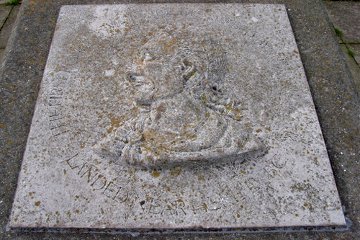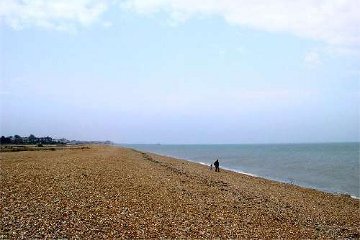Caesar's Tides
In 55 BC Julius Caesar invaded Britain, but the exact date and location of the invasion have remained an unsolved puzzle for years. Many history books favour the date of 26/27 August and a location near Deal to the north-east of the cliffs of Dover. However tidal experts have disagreed over the site, pointing out that the tide streams on that date flowed towards the south-west of Dover - that is, away from Deal.

| |
| This plaque on Deal beach marks the spot where Julius Caesar came ashore on his invasion of Britain. |
The debate, it seeems, has at last been resolved. During August 2007 natural conditions were remarkably similar to those of August 55 BC, when Caesar launched his invasion. Such conditions have not existed since 1901 and will not be the same again until 2140. So August 2007 provided a rare opportunity to shed light on the subject. Texas state physics professors Donald Olson and Russell Doescher, together with honours students Kellie Beicher and Amanda Gregory, took up the challenge and worked together to settle the matter once and for all. The team used scientific observation and compared their results to the writings of Julius Caesar himself.
In his Gallic Wars, Caesar described his 55 BC invasion in some detail. It was launched, he wrote, to punish the Birtons for contantly reinforcing his Gallic enemies. Perhaps the idea of securing the local tin trade market also appealed to him. In any case, 80 transport vessels shipped two whole legions - around 10,000 soliders - towards the cliffs of Dover where they changed direction and followed the coast for around seven miles, landing finally "on an evenly sloping beach free from obstacles", to quote Caesar. That same day the locals gave battle. Defeated, the Britons regrouped and attacked again a week later, but were fought back once more. Smarting, the local Britons sued for peace.
Caesar's account, however, raises some problems. He supplied no specific date and, owing to the general lack of knowledge among the Romans about British geography, did not name the location of his landing. That location's identity is even further compounded since he never specified the direction his fleet took from Dover. Because of this, many experts have been forced to speculate and debate the date and site of the landing.
Nonetheless, the details he did leave us are revealing. These are, the "evenly sloping beach" around seven miles from Dover, the full moon, which took place on the fourth night after the first battle, and the tides, that were "particularly high" during that full moon.

| |
| Deal beach certainly fits Caesar's description of a gently shelving beach. |
The first detail certainly points to the location of Deal, about seven miles to the north-east of Dover, the only possible coastal site fitting Caesar's description. The second, if we use lunar calculations, indicates the landing date not on the traditional 26/27th of August but actually a few days earlier, the 22/23rd of August. But it is the third detail - the high tideal streams during the full moon, which experts say were flowing way from Deal, and how this can be reconciled with the other details mentioned - where Olson and his team's findings come into effect.
According to Olson, in August 2007 his team simply "realised we could go out in a boat and observe the current for ourselves". Using GPS tracking on a free-drifting boat and the super high-tech method of throwing apples into the channel to see which way they would float, they discovered that during 26/27 August 55 BC the tides were very high indeed. But in light of Caesar's observation that the high tides occurred four days after his landing, this suggests that the 26/27 August was some four days after that landing, again indicating, like the lunar calculations, that 22/23 August is the landing date.
Crucially, while Olson's team found that the current during 26/27 flowed to the south-west of Dover - in the opposite direction to Deal, just as tidal experts have long held, they also discovered that during 23/23 August the current actually flowed from Dover towards Deal.
What does all this mean? Well, by lunar calculation and tidal observation, together with Caesar's testimony, 22/23rd August 55 BC must have been the date for Julius Caesar's landing on British shores, which in light of the evidence, was at Deal after all, just as historians have suspected. So history and science have combined to settle on this important site and date in history.
Olson has summed up the situation well by stating, "The scientists were right about the tidal streams and so were the historians about the landing site. With our new result and our new date, everything is reconciled."
©David Down 2008





